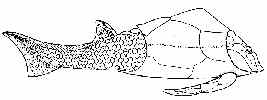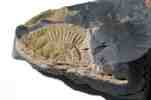|
Latest
3 June 08
5.00 pm
19 May 08 The lecture will be illustrated with fossil fish and reconstructions of how they looked in life, together with interpretations of the Devonian environment in Caithness.
5 June 07 The draft Fossil Code has been developed by Scottish Natural Heritage (SNH) in response to irresponsible collecting by collectors using crowbars, sledgehammers and powered rock saws which has damaged internationally important fossil locations across Scotland. Some fossils are known to be illegally traded on the international market and special sites in Skye, Caithness, Ayrshire and Lesmahagow in south Lanarkshire, are all under threat from irresponsible collecting. Minister for the Environment Michael Russel said: "The fossil heritage of Scotland is incredibly important to Scotland's people as a scientific, educational and recreational resource. At this, the beginning of the public consultation on the draft Scottish Fossil code, we are calling for all those who recognise its remarkable and irreplaceable value to take part and have their say in how fossils should be collected and cared for. It is especially good to see young people here today learning about Scotland's fabulous fossil heritage in the very heart of the capital city beside two of our most celebrated modern sites." SNH Chairman Andrew Thin said: "Small-scale fossil collecting is a popular hobby and amateur collectors often uncover rare and very important finds which can add to our wider understanding and body of knowledge. It is vital for the development of geological science that young people especially are encouraged to take an interest in our world-class fossil heritage and that responsible collecting, as outlined in the draft Code, continues. " SNH produced the draft Code with assistance from fossil collectors, landowners, palaeontological researchers, Scotland's museums and others with an interest in Scotland's fossil heritage. The aim of the Scottish Fossil Code is to establish a nationally agreed framework of advice on best practice in the collection, identification, conservation and storage of fossil specimens. It also sets out guidelines on how to collect and look after fossils in a responsible way without damaging them or the areas where they are found. Dr Colin Galbraith, SNH Director of Policy & Advice said: "Scotland boasts some of the rarest and most scientifically important fossils in the world, from some of the earliest land plants and fossil fish to early mammal and dinosaur remains. However, in some areas of the country, the fossil heritage is threatened by irresponsible collecting that causes tremendous damage and threatens to annihilate vulnerable sites and the fossils they contain. The Scottish Fossil Code will inform the public about Scotland's fascinating fossil heritage and the importance and fun of fossil collecting, but crucially it will also encourage the responsible collecting and care of fossils." The launch took place alongside an educational 'Fossils in the City' event at Our Dynamic Earth for P4 and 5 pupils from Abbeyhill Primary School in Edinburgh. 'Fossils in the City' demonstrates that Scotland's fossils are to be found everywhere - from the heights of Arthur's Seat to the paving stones of Edinburgh's streets. It is a little known fact that although Arthur's Seat was a volcano, fossils of plants can be found in the volcanic ashes that once covered the slopes of this once volcanic island. Mrs Irene Brennan, Head Teacher of Abbeyhill Primary School said: "Fossils have a fascinating and inspiring role to play in children's education. This has been reflected in the discoveries our pupils have made today here in the heart of Edinburgh and their excitement at seeing real Scottish fossil plants and animals. Their enthusiasm shows how much young people can learn from and be inspired by Scotland's fossil heritage. The launch of the Fossil Code today also highlights the importance of adding to that heritage by collecting more fossils responsibly." Electronic copies may be downloaded from www.snh.org.uk/fossilcode Obituary For Jack Saxon - Caithness Field Club 2006
29 September 05 August 05
29 May 04
13 February 03
See Also |
A Geological Tour of the North (by Jack Saxon) A New Fossil Fish By Jack Saxon 2004 Achanarras - A Window on the Glorious Devonian
A New Fossil Discovery At Achanarras Quarry The Orcadian Middle Old Red Sandstone THE JURASSIC BOULDER BEDS OF EAST SUTHERLAND 370 Million Year Old Discovery Robert Dick's Fossil Collection
Cyclic Sedimentary Structures Of North Sutherland by Jack Saxon
First published in the Caithness Field Club Bulletin 1993. In this article Jack casts his artisitc eye over some of the rocky outcrops and applies his considerable knowledge to reach some interesting conclusions on rocks which he puts in the Mesozoic Age. Halting Fossil Damage And Theft |





